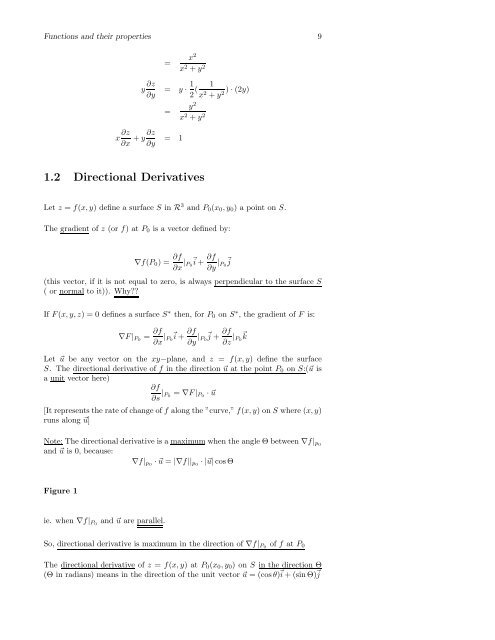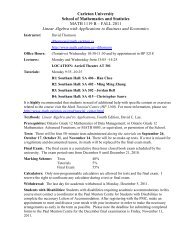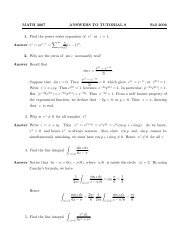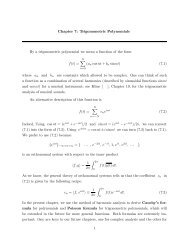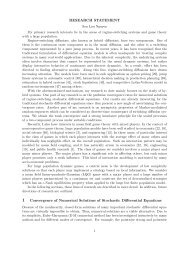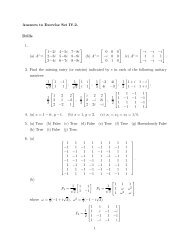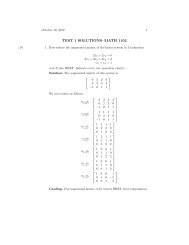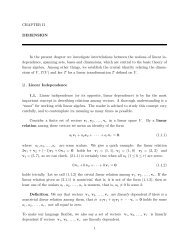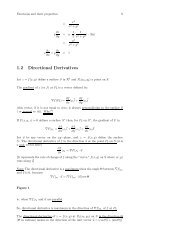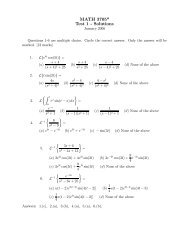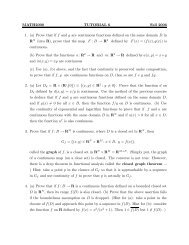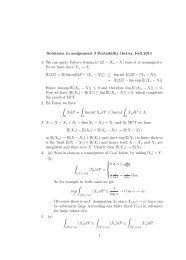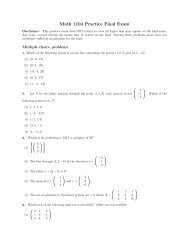1.2 Directional Derivatives
1.2 Directional Derivatives
1.2 Directional Derivatives
You also want an ePaper? Increase the reach of your titles
YUMPU automatically turns print PDFs into web optimized ePapers that Google loves.
Functions and their properties 9<br />
y ∂z<br />
∂y<br />
x ∂z ∂z<br />
+ y<br />
∂x ∂y<br />
=<br />
x 2<br />
x 2 + y 2<br />
1<br />
= y ·<br />
2 (<br />
1<br />
x2 ) · (2y)<br />
+ y2 =<br />
= 1<br />
y 2<br />
x 2 + y 2<br />
<strong>1.2</strong> <strong>Directional</strong> <strong>Derivatives</strong><br />
Let z = f(x, y) define a surface S in R 3 and P0(x0,y0) apointonS.<br />
The gradient of z (or f) atP0 is a vector defined by:<br />
∇f(P0) = ∂f<br />
∂x |P0 i + ∂f<br />
|P0<br />
j<br />
∂y<br />
(this vector, if it is not equal to zero, is always perpendicular to the surface S<br />
(ornormalto it)). Why??<br />
If F (x, y, z) = 0 defines a surface S ∗ then, for P0 on S ∗ , the gradient of F is:<br />
∇F |P0 = ∂f<br />
∂x |P0 i + ∂f<br />
∂y |P0 j + ∂f<br />
∂z |P0 k<br />
Let u be any vector on the xy−plane, and z = f(x, y) define the surface<br />
S. The directional derivative of f in the direction u at the point P0 on S:(u is<br />
a unit vector here)<br />
∂f<br />
∂s |P0 = ∇F |P0 · u<br />
[It represents the rate of change of f along the ”curve,” f(x, y) onS where (x, y)<br />
runs along u]<br />
Note: The directional derivative is a maximum when the angle Θ between ∇f|p0<br />
and u is 0, because:<br />
∇f|p0 · u = |∇f||p0 ·|u| cos Θ<br />
Figure 1<br />
ie. when ∇f|P0 and u are parallel.<br />
So, directional derivative is maximum in the direction of ∇f|P0 of f at P0<br />
The directional derivative of z = f(x, y) atP0(x0,y0) onS in the direction Θ<br />
(Θ in radians) means in the direction of the unit vector u =(cosθ)i +(sinΘ)j
10 The ABC’s of Calculus<br />
Example 9<br />
Find ∂f<br />
∂s |P0<br />
Here f(x, y) =x 2 + xy + y 2<br />
z = x 2 + xy + y 2 , P0 =(3, 1), Θ= π<br />
3<br />
∇f = ∂f<br />
∂x i + ∂f<br />
∂y j<br />
= (2x + y)i +(x +2y)j<br />
∇f|P0 = ∇f| (3,1)<br />
= (2· 3+1)i +(3+2· 1)j<br />
= 7i +5j<br />
Also u = cosΘi +sinΘj<br />
= cos π<br />
3 i +sin π<br />
3 j<br />
= 1<br />
2 i<br />
√<br />
3<br />
+<br />
2 j<br />
Therefore ∂f<br />
∂s |P0 = ∇f|P0 · u<br />
= (7i +5j) · ( 1<br />
2 i +<br />
= 7<br />
2 + 5√3 2<br />
Example 10 z =2x 2 +3xy − y 2 at (1, 1) toward (2, 1).<br />
√ 3<br />
2 j)<br />
Here f(x, y) =2x 2 +3xy − y 2 , ∇f =(4x +3y, 3x − 2y) or ∇f| (1,−1) =(4· 1+<br />
3(−1), 3(1) − 2(−1)) = (1, 5)<br />
To find u we need to find a vector from (1, 1) to (2, 1). This is given by v =<br />
√(2, 1) − (1, −1) √ = (1, 2). Tomakevinto a unit vector we divide v by its length:<br />
12 +22 = 5.<br />
Therefore u = v (1, 2)<br />
= √ =(<br />
|v| 5 1<br />
√ ,<br />
5 2<br />
√ )<br />
5<br />
∂f<br />
∂s | (1,−1) = ∇f| (1,−1) · u<br />
= (1, 5) · ( 1<br />
√ ,<br />
5 2 √ )<br />
5<br />
=<br />
1<br />
√ +2<br />
5 √ 5<br />
√<br />
5<br />
=<br />
5 +2√5 = 11√<br />
5<br />
5
Functions and their properties 11<br />
What is its maximum value? When:<br />
u = ∇f<br />
|∇f| |P0 : ∂f<br />
∂s | (1,−1) = 1 2 +5 2 = √ 26<br />
1.3 Maxima and Minima Subject to Constraints<br />
To look for maximum and minimun of functions of two variables, z = f(x, y)<br />
we set:<br />
∂f<br />
∂f<br />
=0 and<br />
∂x ∂y =0<br />
and look for those points P (x, y) atwhichbothof these hold. If, at such P ,<br />
( ∂2f ∂x∂y )2 − ( ∂2f ∂x2 )(∂2 f<br />
) < 0<br />
∂y2 and<br />
1) ∂2f ∂x2 + ∂2f ∂y2 > 0<br />
OR:<br />
at p ⇒ relative minimum at p<br />
2) ∂2f ∂x2 + ∂2f ∂y2 < 0 at p ⇒ relative maximum at p<br />
3) ∂2 f<br />
∂x 2 + ∂2 f<br />
∂y 2 =0 atp ⇒ Undetermined: need more info.<br />
NOTE : The boundary of the domain of f must always be checked separately for<br />
relative maximum or minimum values.<br />
Example 11 z =2x +4y − x 2 − y 2 − 3 (= f(x, y))<br />
(Domain of f is the whole plane R 2 ), (so boundary of domain is at ∞)<br />
So we need:<br />
(1, 2) is only possible candidate<br />
∂z 0= ∂x =2− 2x ⇒ x =1<br />
=4− 2y ⇒ y =2<br />
0= ∂z<br />
∂y<br />
so x =1, y =2. This means that (1, 2) is the only critical point inside dom(f).<br />
At P0:<br />
[( ∂2 f<br />
∂x∂y )2 +( ∂2 f<br />
∂x 2 ) · (∂2 f<br />
∂y 2 )](1, 2) = (0)2 − (−2)(−2) = −4 < 0 O.K.<br />
So go to the next step, At P0:<br />
[( ∂2f ∂x2 )+(∂2 f<br />
)](1, 2) = (−2) + (−2) = −4 < 0<br />
∂y2 By this second derivative test, therefore relative maximum at (1, 2).
12 The ABC’s of Calculus<br />
Example 12 Find positive numbers x, y, z such that x + y + z =12and xy 2 z 3<br />
is a maximum.<br />
So, here we want to maximize the function xy 2 z 3 subject to the constraint x +<br />
y + z =12.<br />
But then z =12−x−y and so we wnat to maximize the function of two variables<br />
f(x, y) =xy 2 (12 − x − y) 3 over those x>0,y >0.<br />
Now,<br />
0= ∂f<br />
∂x = y2 (12 − x − y) 3 + xy 2 · 3(12 − x − y) 2 (−1)<br />
= (12−x−y) 2 y 2 [(12 − x − y)+x(−3)]<br />
= (12−x−y) 2 y 2 next<br />
(12 − 4x − y)<br />
0= ∂f<br />
∂y = 2xy(12 − x − y)3 + xy 2 · 3(12 − x − y) 2 (−1)<br />
= xy(12 − x − y) 2 [2(12 − x − y) − 3y]<br />
= xy(12 − x − y) 2 (24 − 2x − 5y)<br />
so we need to find those x, y for which,<br />
and<br />
(12 − x − y) 2 y 2 (12 − 4x − y) =0<br />
(12 − x − y) 2 xy(24 − 2x − 5y) =0<br />
there are many possiblilities – Each one must be considered in turn.<br />
1) One possibility is that (12 − x − y) 2 =0⇒ x + y =12<br />
In this case, since x+y+z =12and x+y =12⇒ z =0and so xy 2 z 3 =0<br />
is a ”minimum” (as x, y, z are all assumed positive).<br />
2) Another possibility is tah y =0but again this gives a minimum.<br />
3) Yet another possibility is that 12 − 4x − y =0Now from the second equation<br />
there are two sub-cases (Why?):<br />
a) x =0<br />
b) 24 − 2x − 5y =0<br />
a) x =0As before this gives xy2z 3 =0, a minimum.<br />
b) 24 − 2x − 5y =0and 12 − 4x − y =0have the common solution<br />
(x, y) =(2, 4).<br />
So the only possible critical point which can give a maximum is: (x, y) =(2, 4)<br />
For (x, y) =(2, 4), z=12− x − y =12− 2 − 4=6.
Functions and their properties 13<br />
<br />
Now at (2, 4) =<br />
[( ∂2 f<br />
∂x∂y )2 +( ∂2 f<br />
∂x 2 ) · ( ∂2 f<br />
∂y 2 )] < 0<br />
And calculations show that the above is a maximum.<br />
Maximum value<br />
xy 2 z 3 = (2)(4) 2 (6) 3 =32· 6 3<br />
Remarks: In many of these problems we are faced with solving systems of<br />
equations of the form:-<br />
ABC =0<br />
Where A, B, C are functions of several variables.<br />
Then the cases are:<br />
A = 0 B = 0 C =0<br />
A = 0 B =0 C = 0<br />
A = 0 B =0 C =0<br />
A =0 B = 0 C =0<br />
A =0 B =0 C = 0<br />
A =0 B =0 C =0<br />
A =0 B = 0 C = 0<br />
and each one must be treated separately.<br />
1.4 Constrained Maxima and Minima: Method<br />
of Lagrange<br />
This techmique is used for finding the maximum and minimum of functions<br />
z = f(x, y) subject to some additional constraint, like:<br />
The idea is then:<br />
1) Form the function<br />
h(x, y) = f(x, y)<br />
<br />
Origional<br />
φ(x, y) =0<br />
+ λ<br />
<br />
Lagrange multiplierf(x,y)<br />
2) Solve ∂h ∂h<br />
∂x =0, ∂x = 0 for all possible x, y and λ.<br />
constraint<br />
<br />
φ(x, y)
14 The ABC’s of Calculus<br />
3) Continue as in previous section.<br />
Example 13 Find area of largest rectangle which can be inscribed in a semicircle<br />
of radius a with base on its diameter.<br />
Denote rectangle’s sides by: 2x, y<br />
Figure 2<br />
We want to maximize the area of the rectangle, i.e. A(x, y) =sxy subject to<br />
constraint that ”rectangle is inscribed in semicircle”. This means that x 2 + y 2 =<br />
a 2 (see diagram) or, φ(x, y) =x 2 + y 2 − a 2 =0.<br />
UseLagrangemultipliers:So let h(x, y) =2xy + λ(x 2 + y 2 − a 2 )<br />
Then:<br />
Also<br />
∂h<br />
=0⇒ 2y + λ(2x) =0 ie. λx + y =0<br />
∂x<br />
∂h<br />
=0⇒ 2x + λ(2y) =0 ie. λy + x =0<br />
∂y<br />
From the first of these two we get λ = −y<br />
x (if x = 0).<br />
(an assumption which is good, since if x =0⇒ no area)<br />
Substitute this value of λ = −y<br />
x<br />
−y 2<br />
into the second equation, to find:<br />
x + x =0 or x2 = y 2 ⇒ x = ±y<br />
Since we can assume x>0,y >0, thismeansx = y.<br />
Now:<br />
x 2 + y 2<br />
or 2x 2 =7a 2<br />
or x =<br />
= a 2<br />
⇒ x 2 + x 2 = a 2<br />
a<br />
√ 2<br />
Thus x = a √ 2 ,y = a √ 2 is an extreme point and:<br />
Area = 2xy<br />
= 2· a √ ·<br />
2 a √<br />
2<br />
= a 2
Functions and their properties 15<br />
Example 14 Find the shortest and largest distance from the origin to the curve<br />
x 2 + xy + y 2 =16and give a geometric iterpretation.<br />
HINT: find the maximum of x 2 + y 2 .<br />
CONSTRAINT: x 2 + xy + y 2 =16<br />
[h(x, y) =x 2 + y 2 + λ(x 2 + xy + y 2 − 16)]<br />
∂h<br />
∂x<br />
= 2x + λ(2x + y) =0 1<br />
∂h<br />
∂y<br />
= 2x + λ(x +2y) =0 2<br />
∂h<br />
∂λ = x2 + xy + y 2 − 16 = 0 3<br />
Now: if 2x + y =0,thenx =0too! but then y = −2x =0too! so x =0, y =0<br />
is only possibility here for 1 .<br />
NOTE: x =0, y =0satisfied 1 , 2 ,butnot 3 so 2x + y = 0can solve for λ<br />
λ = −( 2x<br />
2x+y ) from 1<br />
so we feed this value of λ into 2<br />
2y +(− 2x<br />
)(x +2y)<br />
2x + y<br />
= 0<br />
2y(2x + y) − 2x(x +2y)<br />
2x + y<br />
= 0<br />
so y(2x + y) − x(x +2y) = 0<br />
y 2 − x 2 = 0<br />
⇒ y = ±x<br />
finally set y = ±x into constraint equation x 2 + xy + y 2 =16.<br />
Which leaves two cases: y = x and y = −x<br />
case 1: y = x ⇒ x 2 + x 2 + x 2 =16or 3x 4 =16<br />
x = ± 4 √ 3 But y = x ⇒ y = ± 4 √ 3 too!
oy-<br />
16 The ABC’s of Calculus<br />
case2: y = −x ⇒ x 2 − x 2 + x 2 =16or x 2 =16.<br />
So we get four critical points:<br />
x 2 + y 2<br />
32<br />
3<br />
32<br />
3<br />
32<br />
32<br />
x 2 + y 2<br />
<br />
32<br />
3<br />
32<br />
3<br />
√<br />
√<br />
32<br />
32<br />
x = ±4 But y = −x ⇒ y = ±4 too!<br />
x = 4 √ 3<br />
check critical points for max/min.<br />
, y = 4 √ 3<br />
x = − 4 √<br />
3<br />
, y = − 4 √<br />
3<br />
x =4 , y = −4<br />
x = −4 , y =4<br />
Note that maximum is at (4, −4) and (−4, 4) and the value at this point is √ 32<br />
Note that minimum is at (± 4 √ 3 , ± 4 √ 3 ) and the value here is<br />
1.5 Double and Iterated Integrals<br />
32<br />
3<br />
Let domain f = R and write z = f(x, y) continuous over a finite region R of<br />
the x, y plane. We divide R into n subregions area ∆A1, ∆A2, ......, ∆An in any<br />
fashion what so ever.<br />
Figure 4<br />
Next we pick a point (x1,y1), (x2,y2), ......, (xn,yn) in each one of these subregions<br />
and form the sum:<br />
n<br />
f(xi,yi)∆Ai = f(x1,y1)∆A1 + ...... + f(xn,yn)∆An<br />
i=1<br />
Think about f(xi,yi)∆Ai : This is the signed volume of a parallelepipeds of<br />
base area ∆Ai and height f(xi,yi).


